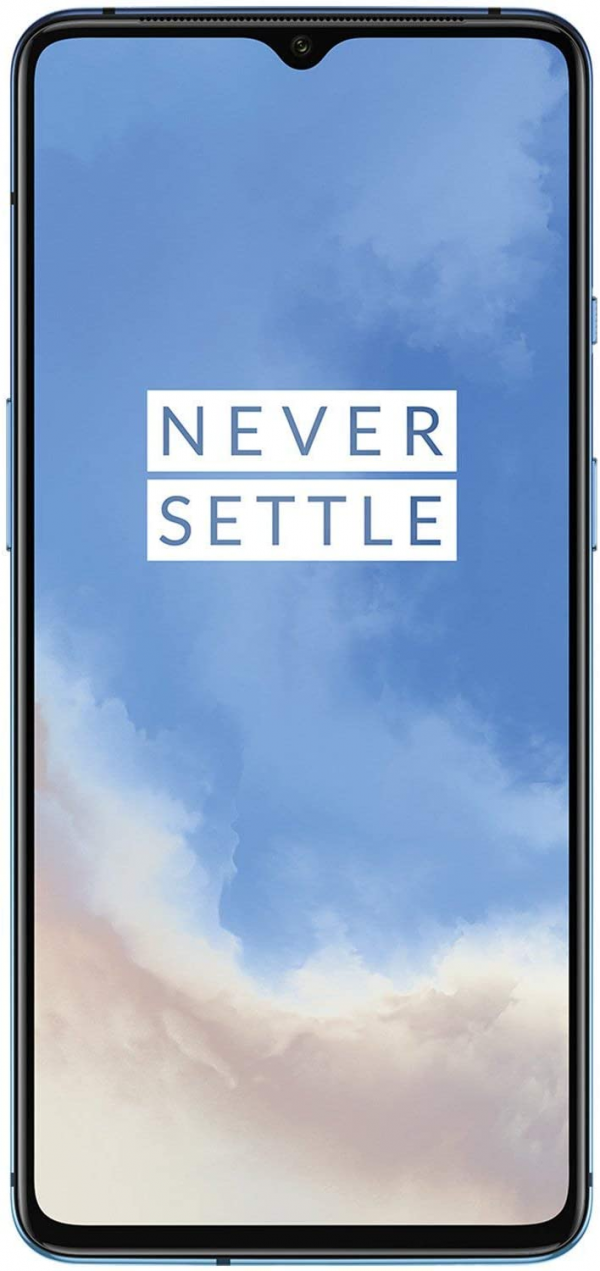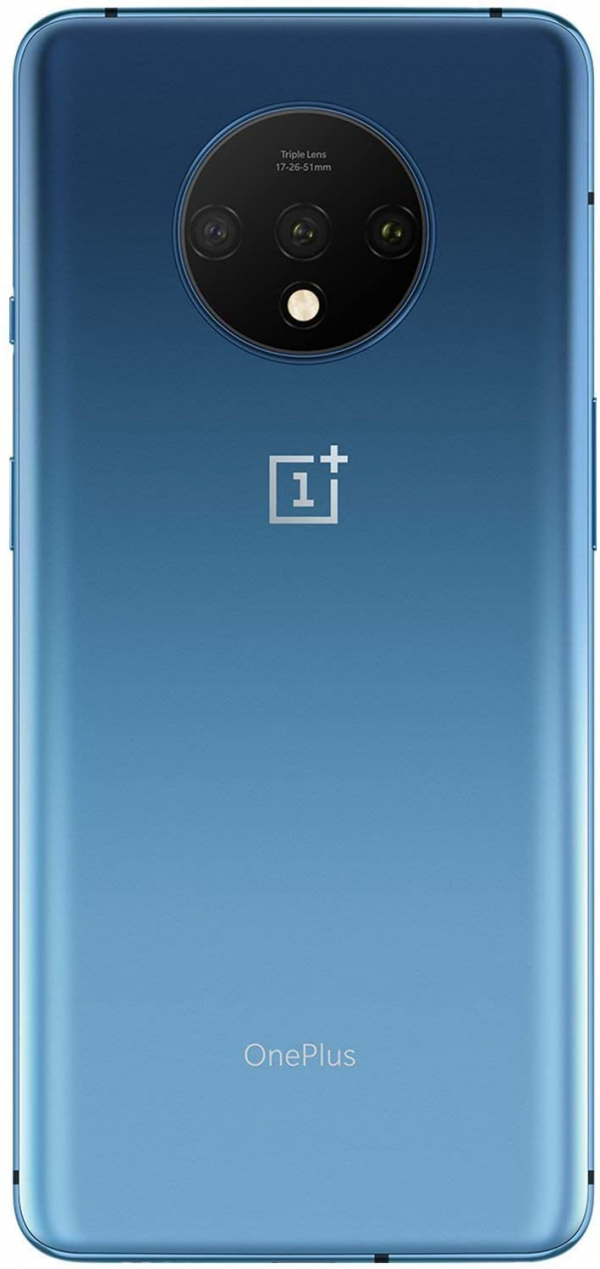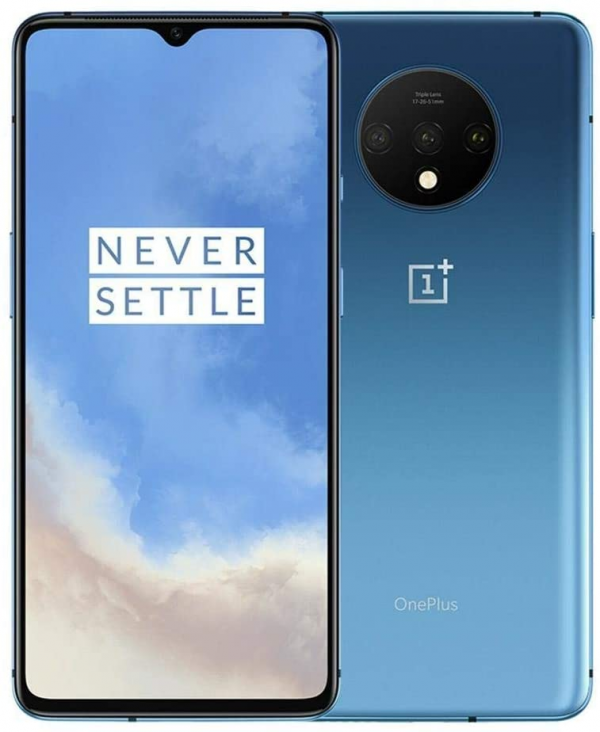OnePlus
OnePlus 7T: one of the most powerful smartphones on the market
Aprox. 498€ - see price -
See specificationsThird new smartphone of 2019 for OnePlus, the 7T is none other than the update of the OnePlus 7 released in May. The biggest fans will be delighted with the improvements. Newcomers will discover a mobile that is always well balanced.
Our review
Presentation
Five months after the announcement of the OnePlus 7 and the OnePlus 7 Pro, the Chinese manufacturer returns with a new model, the OnePlus 7T. This new model is inspired by the OnePlus 7 by providing it with 3 photo sensors, a new processor or even a 90 Hz screen.
At the time of this writing, OnePlus has not yet communicated on the price of the 7T, but one can easily imagine that it should be close to that of the OnePlus 7 when it is released (€ 559 as a reminder). Its direct competitors could then be the Xiaomi Mi 9T Pro, the Asus Zenfone 6, the Xiaomi Mi 9 or even the Google Pixel 3a XL, to name a few.

Ergonomics and design
At first glance, the OnePlus 7T looks a lot like the previous OnePlus 7. The differences are noticeable in a few details. The mobile that interests us today adopts a slightly larger template - it is a bit higher, of the order of the size of a teardrop notch. It is one millimeter wider, but remains less than 10 mm wider compared to the OnePlus 7 Pro. In hand, the phone is relatively light (190 g).
At the front, there is not much except a notch in the shape of a drop of water. The Fluid Amoled screen has a definition of 2,400 x 1,080 px and occupies approximately 88% of the total surface. The fingerprint sensor is located below, as in the two previous iterations of OnePlus.
It's when you linger on your back that you spot the biggest change. The sensors now rest on a round island - like what we saw on the Huawei Mate 30 Pro, for example. The polished glass finish of this OnePlus 7T is similar to what we saw on the OnePlus 7 Pro. Very pleasant to the touch, it ensures a good grip, although a little slippery at times.
The slices are fairly standard. On the right, there is the start button as well as a button to slide to switch between silent, vibrating and ringing modes. Opposite are the volume controls. On the lower edge are placed the USB-C port, a speaker and the slot that can accommodate up to 2 SIM cards.
Like the previous two models, the OnePlus 7T is deprived of a 3.5 mm mini-jack. There is also no adapter delivered to connect your favorite headset. It will therefore be necessary to use USB-C headphones or prefer the use of a Bluetooth device.
Rare thing, these are two speakers (one on the low edge and the other, just above the screen) which deliver here a rather good sound, close to what we could observe on the Pro version OnePlus 7.

Screen
With its 7T, OnePlus brings 90 Hz to a more affordable terminal. And let's say at the outset, the proposed slab is of excellent quality. With its diagonal of 6.55 inches, it displays in 2,400 x 1,080 px for a resolution of 405 ppi. It is however necessary to take a quick tour in the settings of the device in order to make the most of it. We therefore recommend that you access the parameters, choose the display tab, open the choice of screen profile and opt for Natural mode; Vivid mode being unconvincing. This done, you will get an average delta E of 2.3. This value means that the color drifts of the screen are generally so weak that they appear imperceptible to the human eye. If videographers calibrate their screen to 6,500 K to work, you will have here a 7,010 K screen, close enough to the video standard to be satisfied. Oled obliges, the contrast of the slab tends towards infinity.
To guarantee optimal comfort, the OnePlus 7T panel is capable of climbing up to 566 cd / m² and going down to 2 cd / m². It therefore remains legible in full sun and does not damage the retinas in the most complete darkness. It also offers a fairly good reactivity, with a tactile delay of 72 ms. Finally, its only gap is on the side of the reflectance, much too high (53.2%).
Performances
In terms of performance, the OnePlus 7T offers a paradoxical experience. Equipped with 8 GB of RAM and a Snapdragon 855+ chip, one of the most powerful on the market today, the smartphone delivers excellent results in multitasking (index 99.89) and is positioned on the second of our podium, just behind ... the OnePlus 7 Pro (100).
On the other hand, things are spoiling on the side of the game. The OnePlus 7T achieves here a halftone performance (score of 53.28). It is a little worse than the 7T Pro (59.77), but above all that its direct competition. This translates into disappointing graphics and framerate compared to a Xiaomi Mi 9T Pro, a Samsung Galaxy S10e or even a P30 Pro.
This gap brings down the overall performance index of this 7T, which is finally positioned at 76.58, a little below its direct competition, whether on the lower or higher price bands.
Photo
There will obviously be two schools in 2019. On the one hand, the Americans (Apple, Google), who opt for square photo islands on the back of their smartphones, and on the other, the Chinese, who prefer rounding. Unsurprisingly, OnePlus is therefore in the second camp, accompanying Huawei. At the heart of its island, the 7T houses three modules: the main, with a 48 MP sensor and a lens opening at f / 1.6 (equivalent to 26 mm in 24x36); the second, dedicated to the very wide-angle, offers a 16 MP sensor supported by a lens opening at f / 2.2 (equivalent 17 mm); finally, the third and last module offers a 2x "telephoto" (8 MP, f / 2.2, eq. 51 mm).
With the basic settings, the 7T captures snapshots in 12 Mpx, despite the definition of its sensor in 48 Mpx. The reason is as always the action of the pixel bining, a technique allowing to combine four pixels in order to catch more light at night. It is however possible to switch to 48 MP via the parameters of the manufacturer's photo application.
It must be admitted that the pictures are disappointing. By day, the OnePlus 7T strongly overexposes the scene. So we are left with burnt whites and bland colors. To make matters worse, a loss of detail is felt at the periphery. These results are all the more regrettable as the image processing operated by OnePlus 7T turns out to be rather light. We therefore find a controlled smoothing, letting all the details show through in the image, especially in the center.
At night, the result is strangely more convincing. The scene is better exposed and remains perfectly legible. A lot of details are present. To obtain this result, OnePlus chose to extend the pause time (1/10 s) and maintain the sensitivity (5000 ISO). Unfortunately, the colors are still discreet.
For its part, the night mode (available in the application concocted by OnePlus) is content to accentuate the contrasts, even if it means delivering more artistic than realistic results.
By day, the very wide-angle module of the OnePlus 7T suffers from the same problems as the main module. We thus find an overexposed scene and bland colors. Added to this is a little more present image processing, erasing certain details of the image. But overall, the result remains more than correct in the face of competition still groping on its secondary modules; proof is the result of the Xiaomi MI 9T Pro.
As always with very wide angle modules, things are much less brilliant at night. The result is here drowned out under the image smoothing and only the center of the photo turns out to be correctly exposed. The entire periphery is therefore found in the dark. Result, a cliche little exploitable.
The 2x telephoto module of the 7T offers satisfactory shots. The scene turns out to be correctly exposed and the colors faithful. A touch of smoothing is regrettable, but nothing too serious. We are facing here clichés of good quality.
Like its competitors, the 7T switches to its main module when the light runs out. Impossible to judge the quality of the third night module therefore.
The 16 MP front sensor offers rather satisfactory selfies. The camera is not too abrupt by the strong lights and, in fact, correctly exposes the scene. The portrait mode is doing admirably well, the clipping is effective and the blurring effect is fairly well balanced - even if we would have liked to be able to adjust it ourselves.
The macro lens, although anecdotal, works well. Much better than on an Honor 20 Pro, but not yet at the level of what is offered on the Huawei P30 Pro.
Finally, on video, you can film up to 4K at 60 frames per second with electronic stabilization (EIS) which effectively limits tremors.
Autonomy
The OnePlus 7T arrives with a 3,800 mAh battery. Not as enduring as on the OnePlus 7 and OnePlus 7 pro, it will still last 16 h 05 min before running out.
On the other hand, for recharging it is a real racing beast. It takes a hair more than an hour to get 100% battery thanks to the fast charger at 30 W.
Conclusion
The OnePlus 7T brings welcome changes like a third sensor or the screen at 90 Hz and is therefore a continuation of the OnePlus 7 - which also remains an excellent mid-range smartphone. It will easily delight those who wish to invest in one of the most powerful phones on the market, without aiming for the top of the basket.
Specifications
Reviews


Beware not FCC certified
Buyers beware! This model is not FCC certified and it's been flashed by the seller even though it seems new. The box is label "for use and sell in Chinese market ONLY" (NOT A GLOBAL VERSION)
100% flagship quality for the non flagship price tag (w/ a SIM SLOT ISSUE-UPDATED REVIEW)
After 1 month of use, absolutely awesome phone, no issues at all. Battery life is great, with one charge it usually lasts all day (heavy use). The fingerprint scanner is on point, combined with the face id, the unlocking of the phone is quick. The camera is much closer to 1000 $ flagships than it used to be in OP phones. I love the fact that it has a flat screen, and the 90 Hz are just something amazing, you won't want to come back to 60 Hz ever.
The best you can get for the money, absolutely no complains, totally recommended.
UPDATE:
After one month of using the phone with total normality with everything working fine I started to recieve a "SIM 1 not allowed" notification and with it all my cellular data wouldn't work. At first, I restarted the phone and the issue went away, but later the same day restarting the phone wouldn't help at all and the issue persisted, I took out the sim many times and placed it back again on the sim slot 1 and still the problem persisted. I contacted my carrier and they told me it's likely that is a malfunctioning of the phone because I then swapped the same sim card to the sim slot 2 and it is still working just fine until today. NOT SURE if it's just my device with a random issue or if it's because this is the chinnese model.
I'll update if the issue appears again with the sim in slot 2.
Just as described!
I cannot be more satisfied with this purchase, it came fast and properly. The phone is awesome and this was the best price I could find over the internet. It says Chinese version in the description, but it came with the global rom, ready to use. Fan-tas-tic!
Awesome is the word. Move over Samsung, Apple
Brought it during Thanksgiving. Awesome delivery came within 2 days. Used the phone now for nearly a week. All things awesome. Best phone even bought, the smoothness is only comparable by iPhone evens beats iPhone in many respects. Awesome camera, baterry and Oxygen OS takes the cake. Never there and never will be such a fluid operating system in Android. Thank you Oneplus.
Good Value For The Price
I have been really impressed with this phone. I rate it this high because it's not my first phone from this company. I have a one plus 7 and really enjoyed the user experience with it. it's like having a google pixel phone but a better user experience with the software. also, one plus has made major improvements to the camera that makes these phones very compelling.
Great Phone
This is a fantastic phone. I was skeptical of how much better it would be than my previous phone (an LG G6) but it really is FAST. Applications that felt slower on my old phone feel quick and responsive on this 7t.
The screen really is beautiful, and the cutout is hardly noticeable and looks really good. I haven't used the camera extensively, but the night mode took some impressive photos that were clearer than just using my eyes alone in a fairly dark room. The OxygenOS version of the Android 10 operating system is just plain great, and everything looks clean and has great features without feeling busy or overdone.
The only thing I would change is the maximum call volume (when not on speaker phone). It can sometimes feel a bit too quiet, even on full volume, though that is usually in areas where the ambient noise is louder.
I would recommend getting a case for this phone, as it is very slippery alone. It does come with a clear case that may be enough, but I bought another case ... just in case.
I highly recommend it!
Amazing Phone. Amazing Price
This is my first OnePlus phone and it really does live up to the hype. I swapped my SIM card out of my old S8 and I was instantly making calls on T-Mobile. Phone is almost bloatware free and really fast. I had a few issues with the auto brightness feature (many posts about this on the web) but the auto learn feature worked great and after a week, it now works perfect. By far the best bang for the buck for a quality phone. Thanks OnePlus and Gotham Cells !!
Not bad at all!
This phone is extremely snappy with the sd855 + and the high refresh rate screen. The look and feel are on par with other flagships. In screen fingerprint reader makes unlock feel instant. Warp charge is super fast. The downsides are that 1. Battery life is only average because of the 90hz screen 2. Facial recognition is rumored to be less secure even when compared to other company's front-cam only solutions 3. No IP rating, but there's no us warranty anyway. Overall it's a great product, and I would totally recommend it to anybody who are in the market for a fast, clean cellphone.